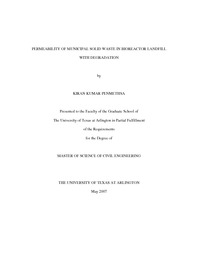
ATTENTION: The works hosted here are being migrated to a new repository that will consolidate resources, improve discoverability, and better show UTA's research impact on the global community. We will update authors as the migration progresses. Please see MavMatrix for more information.
Show simple item record
| dc.contributor.author | Penmethsa, Kiran Kumar | en_US |
| dc.date.accessioned | 2007-08-23T01:56:21Z | |
| dc.date.available | 2007-08-23T01:56:21Z | |
| dc.date.issued | 2007-08-23T01:56:21Z | |
| dc.date.submitted | May 2007 | en_US |
| dc.identifier.other | DISS-1711 | en_US |
| dc.identifier.uri | http://hdl.handle.net/10106/247 | |
| dc.description.abstract | Bioreactor landfills are operated and controlled to accelerate refuse decomposition, gas production and biological stabilization of the municipal solid waste (MSW). Leachate recirculation in bioreactor landfill creates a favorable environment for rapid microbial decomposition of the biodegradable components of solid waste. Therefore, clear understanding of the mechanism of moisture movement within the solid waste would be necessary for successful design and operation of the bioreactor landfill. Permeability is an important parameter during the design of leachate collection
and recirculation system. In the current study an experimental program was designed to
determine the variation of coefficient of permeability of MSW with degradation and to
determine the influence of density and cover soil on permeability of MSW.
MSW samples representing various stages of decomposition were generated in
eight laboratory scale reactors operated under conditions designed to simulate
decomposition in bioreactor landfills. The reactors were destructively sampled at the
end of each phase of degradation based on the reactors methane production rate curve,
PH and volatile organic content. A series of constant head tests were performed on the
representative MSW samples at different stages of decomposition to determine the
variation in permeability with degradation. Tests were repeated at three densities and
two percentages of soil.
Test results indicated a decrease in particle size with degradation which was
mainly due to the breakdown of matrix structure of individual components within
MSW. The coefficient of permeability of MSW decreased from 0.0088 cm/s (Phase I)
to 0.0013 cm/s (Phase IV). There is an overall decrease in the permeability with
increase in density and percentage soil. The trend is the same for the samples at each
phase of degradation. The percentage decrease in permeability is much higher when
there is combined effect of both increase in density and increase in percentage of cover
soil. | en_US |
| dc.description.sponsorship | Hossain, Sahadat | en_US |
| dc.language.iso | EN | en_US |
| dc.publisher | Civil & Environmental Engineering | en_US |
| dc.title | Permeability Of Municipal Solid Waste In Bioreactor Landfill With Degradation | en_US |
| dc.type | M.S.C.E. | en_US |
| dc.contributor.committeeChair | Hossain, Sahadat | en_US |
| dc.degree.department | Civil & Environmental Engineering | en_US |
| dc.degree.discipline | Civil & Environmental Engineering | en_US |
| dc.degree.grantor | University of Texas at Arlington | en_US |
| dc.degree.level | masters | en_US |
| dc.degree.name | M.S.C.E. | en_US |
| dc.identifier.externalLink | https://www.uta.edu/ra/real/editprofile.php?onlyview=1&pid=963 | |
| dc.identifier.externalLinkDescription | Link to Research Profiles | |
Files in this item
- Name:
- umi-uta-1711.pdf
- Size:
- 2.949Mb
- Format:
- PDF
This item appears in the following Collection(s)
Show simple item record


